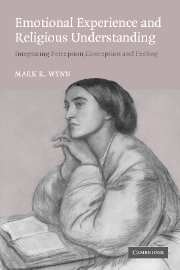Book contents
- Frontmatter
- Contents
- Preface
- Acknowledgements
- 1 Religious experience and the perception of value
- 2 Love, repentance, and the moral life
- 3 Finding and making value in the world
- 4 Emotional feeling: philosophical, psychological, and neurological perspectives
- 5 Emotional feeling and religious understanding
- 6 Representation in art and religion
- 7 The religious critique of feeling
- Bibliography
- Index
1 - Religious experience and the perception of value
Published online by Cambridge University Press: 03 December 2009
- Frontmatter
- Contents
- Preface
- Acknowledgements
- 1 Religious experience and the perception of value
- 2 Love, repentance, and the moral life
- 3 Finding and making value in the world
- 4 Emotional feeling: philosophical, psychological, and neurological perspectives
- 5 Emotional feeling and religious understanding
- 6 Representation in art and religion
- 7 The religious critique of feeling
- Bibliography
- Index
Summary
John and Joan are riding on a subway train, seated. There are no empty seats and some people are standing; yet the subway car is not packed so tightly as to be uncomfortable for everyone. One of the passengers standing is a woman in her thirties holding two relatively full shopping bags. John is not particularly paying attention to the woman, but he is cognizant of her. Joan, by contrast, is distinctly aware that the woman is uncomfortable … John, let us say, often fails to take in people's discomfort, whereas Joan is characteristically sensitive to such discomfort. It is thus in character for the discomfort to be salient for Joan but not for John. That is to say, a morally significant aspect of situations facing John characteristically fails to be salient for him, and this is a defect of his character – not a very serious moral defect, but a defect nevertheless. John misses something of the moral reality confronting him … John's failure to act stems from his failure to see (with the appropriate salience), not from callousness about other people's discomfort. His deficiency is a situational self-absorption or attentional laziness.
In these remarks, Lawrence Blum describes a familiar set of circumstances. Some human beings are habitually more sensitive than others to the needs of their fellows; and in keeping with this passage we could think of this sensitivity as involving, on occasions, a kind of ‘seeing’, one which requires not just grasping the individual elements of a situation (here is a woman, carrying some bags, in some discomfort, and so on), but understanding their relative importance, or seeing them with proper ‘salience’.
- Type
- Chapter
- Information
- Emotional Experience and Religious UnderstandingIntegrating Perception, Conception and Feeling, pp. 1 - 29Publisher: Cambridge University PressPrint publication year: 2005

